Modeling Tomorrow's Energy Infrastructure Today: Researchers model electricity systems for future resource and climate uncertainty
Researchers Model Electricity Systems for Future Resource and Climate Uncertainty

A new modeling approach takes future climate and water resource conditions into account for long-term electricity generation infrastructure planning. Photo courtesy of Pixabay, Pexels
Shifting climate conditions are anticipated to substantially affect U.S. electricity generation in the coming years. However, until now, current analysis has largely overlooked the influence of changing climate and water conditions when planning tomorrow’s energy infrastructure.
Effective planning requires a more comprehensive approach.
That’s why researchers from the National Renewable Energy Laboratory (NREL), along with partners at Sandia National Laboratories and the Advanced Science Research Center at The Graduate Center (CUNY) applied a new modeling approach for long-term electricity generation infrastructure planning.
In their recent article for Environmental Science and Technology, Climate-Water Adaptation for Future US Electricity Infrastructure, researchers consider future climate and water resource conditions and their impact on future electricity generation and infrastructure planning.
Current Constraints and Future Needs
U.S. electricity generation currently relies heavily on thermal generation sources such as coal, nuclear, and natural gas. These power plants require large volumes of water for cooling purposes, and warm ambient temperatures can lower their performance. As our climate warms and water availability changes, it can become more challenging to employ and rely on these generation technologies.
Conversely, renewable sources of energy generation like solar photovoltaic (PV) and wind require little water to operate and are less affected by warmer air temperatures. And while their current share in U.S. energy generation is small, renewable generation is expected to grow.
A confluence of natural, technological, and socioeconomic trends is poised to alter the electricity generation landscape. Growing population translates to growing electricity demands that can be driven higher with rising temperatures. While innovation expands the range of technologies used for electricity generation, aging power plants could leave a gap in electricity supply that is difficult to fill. As electricity system planners balance the need for reliability, affordability, and environmental protection, the evolving generation mix can vary in its vulnerability to changing climate and water conditions.
As planners today look to develop tomorrow’s energy infrastructure, the analysis tools they use must reflect these future realities.
A Clear Picture Minus the Crystal Ball
Electricity capacity planning models play an important role in power sector planning, incorporating technology, market, and policy assumptions to identify low-cost generation mixes that reliably meet demand. Recently recognized by researchers and planners, however, is the need to incorporate climate-water impacts into electricity system expansion studies.
To achieve a better understanding of these impacts, researchers structured their research around four key questions:
- How will future climate and water resource conditions impact four alternative electricity infrastructure scenarios?
- How will the new framework, presented in the study, compare to typical approaches for projecting future electricity generation infrastructure?
- What types of technology choices are needed to adapt to future climate-water conditions and meet reliable electricity-generation levels?
- What are the resulting economic and environmental implications?
To establish a baseline, the researchers first simulated capacity-expansion scenarios without considering climate-water impacts on electricity generation for four electricity mixes: business-as-usual, plus those favoring either coal, nuclear, or renewables. These simulations produced four alternative electricity futures for the contiguous United States that could be compared with simulations that incorporate climate-water impacts into planning decisions.
Researchers then factored climate-water impacts into each electricity mix. They found that reserve generating capacity fell when capacity projections didn’t account for climate-water impacts, creating the potential for reduced grid reliability.
“This is the first time anyone has modeled future electricity infrastructure under climate change using a method that ensures the generation fleet meets reliable power supply thresholds under climate and water constraints,” explained Ariel Miara, the study’s lead author and energy, water, and environment researcher at NREL.
Anticipation and Adaptation
When climate-water impacts are included in projections, researchers found that, by 2050, the U.S. grid could require between 5% and 12% additional power-generating capacity to meet demand and reliability requirements.
Researchers concluded that some thermal power generation will be vulnerable to climate-water impacts in the years ahead, signaling the need for more natural gas and renewable generation in the power mix of the future. And, without climate-water adaptation, tomorrow’s power systems could face reliability challenges, particularly during times of peak demand.
“We showed that power systems may face reliability challenges without climate-water adaptation," said Miara. “Because decisions we make today have long-term consequences, it could be important to consider how these effects might change our approach to planning.”
Read the full article and learn more about NREL’s water research.
This research was funded by the National Science Foundation’s Water Sustainability and Climate Program.
Last Updated May 28, 2025
